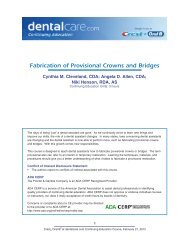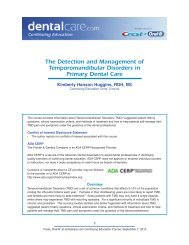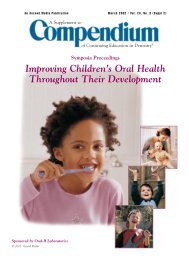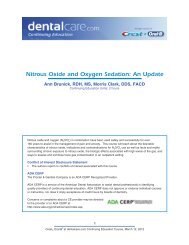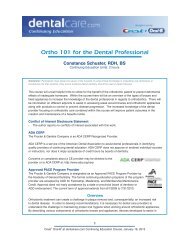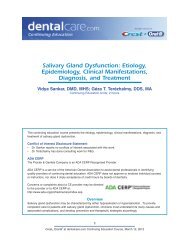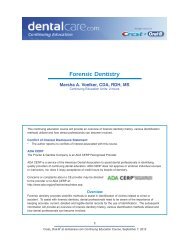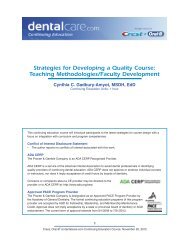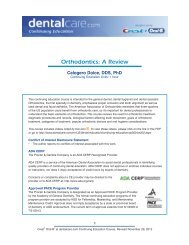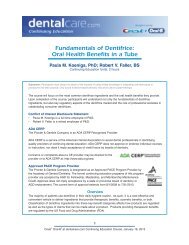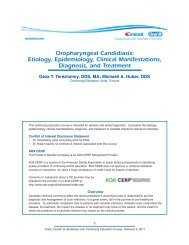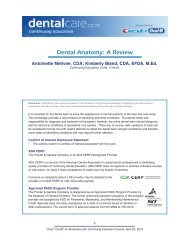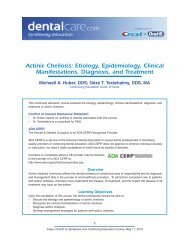CE 391 - Management of Pediatric Medical ... - DentalCare.com
CE 391 - Management of Pediatric Medical ... - DentalCare.com
CE 391 - Management of Pediatric Medical ... - DentalCare.com
You also want an ePaper? Increase the reach of your titles
YUMPU automatically turns print PDFs into web optimized ePapers that Google loves.
• Provide definitive treatment<br />
• Notify 911 if it is determined to be needed<br />
The following sections will discuss the definitive<br />
treatment for the most popular emergencies<br />
encountered in the dental <strong>of</strong>fice.<br />
Syncope<br />
Syncope is the most <strong>com</strong>mon emergency seen in<br />
dental <strong>of</strong>fices (50% to 60% <strong>of</strong> all emergencies).<br />
Although it occurs predominately in adults, since<br />
all pediatric dental patients are ac<strong>com</strong>panied by<br />
an adult it can readily occur in a pediatric dental<br />
<strong>of</strong>fice. Syncope occurs as a result <strong>of</strong> a “fight<br />
or flight” response and the absence <strong>of</strong> patient<br />
muscular movement, leading to a transient loss<br />
<strong>of</strong> consciousness. It is most <strong>com</strong>mon in young<br />
adults, most <strong>com</strong>monly between the ages <strong>of</strong><br />
16 to 35 years and in men more than women,<br />
probably as a result <strong>of</strong> being told to “Take it like<br />
a man” during a stressful situation. <strong>Pediatric</strong><br />
patients rarely develop syncope because they do<br />
not hide their fears and readily react emotionally<br />
and physically during a stressful situation. If a<br />
pediatric patient or an adult older than 40 years<br />
exhibits syncope without predisposing factors,<br />
they should be sent for medical consultation.<br />
Predisposing factors for syncope can be divided<br />
into two categories, psychogenic or nonpsychogenic<br />
factors.<br />
Psychogenic factors include:<br />
• Fright<br />
• Anxiety (due to the anticipation <strong>of</strong> dis<strong>com</strong>fort<br />
or the fee)<br />
• Stress<br />
• Receipt <strong>of</strong> unwel<strong>com</strong>e news (treatment or the<br />
treatment fee)<br />
• Sudden and unanticipated pain (injection or<br />
during treatment)<br />
• The sight <strong>of</strong> blood (gauze, dental instruments)<br />
A parent, with a history <strong>of</strong> negative dental<br />
experiences, ac<strong>com</strong>panying their child for an<br />
emergency dental extraction, who was informed<br />
<strong>of</strong> the treatment fee, and is standing in the<br />
treatment room doorway, observing the extracted<br />
tooth in blood soaked gauze, is a prime candidate<br />
to develop syncope.<br />
Non-psychogenic factors include:<br />
• Sitting in an upright position (especially during<br />
7<br />
the injection) or immobility while standing<br />
resulting in blood pooling in the peripheral<br />
extremities, decreasing the flow <strong>of</strong> blood to the<br />
brain.<br />
• Hunger from dieting or missed meals resulting<br />
in decreased glucose supply to the brain.<br />
• Exhaustion<br />
• Poor physical condition<br />
• Hot, humid environments<br />
The physiological mechanism for the onset <strong>of</strong><br />
syncope is:<br />
• Stress causes increased amounts <strong>of</strong><br />
catecholines (epinephrine, norepinephrine)<br />
to be released into the circulatory system to<br />
prepare the individual for increased muscle<br />
activity (fight or flight reaction in a threatening<br />
situation).<br />
• The responses to the catecholine release are<br />
decreased peripheral vascular resistance and<br />
increased blood flow to the peripheral skeletal<br />
muscles.<br />
If muscle activity occurs (fight or flight), the blood<br />
volume diverted to the muscles is returned to the<br />
heart. If muscle activity does not occur (sitting<br />
or standing still), there is increased peripheral<br />
pooling <strong>of</strong> the blood in the extremities and a<br />
decreased return <strong>of</strong> blood to the heart. This<br />
leads to a decrease in the circulating blood<br />
volume, a drop in arterial blood pressure and<br />
diminished cerebral blood flow resulting in<br />
syncope. Not managing the body’s mechanism to<br />
<strong>com</strong>pensate for the decreased circulatory volume<br />
in a timely manner leads to:<br />
• Reflex bradycardia<br />
• Decreased cardiac output<br />
• Decreased blood pressure<br />
• Cerebral ischemia<br />
• Convulsions<br />
The signs and symptoms <strong>of</strong> syncope are divided<br />
into early and late stages.<br />
In the early stage the patient:<br />
• Expresses feeling warm<br />
• Exhibits loss <strong>of</strong> color with an ashen-grayskin<br />
tone<br />
• Perspires heavily<br />
• Reports “feeling bad” or “feeling faint”<br />
• Reports feeling nauseous<br />
• Exhibits slightly lower blood pressure and<br />
tachycardia<br />
Crest ® Oral-B ®<br />
at dentalcare.<strong>com</strong> Continuing Education Course, May 11, 2012



